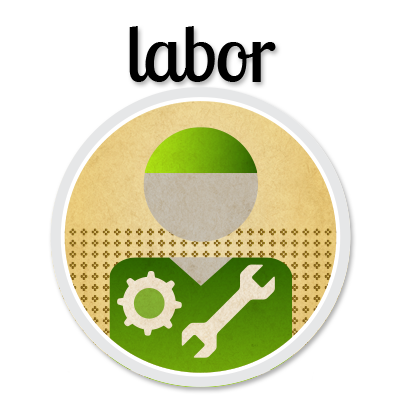

5 min
scroll down and enjoy every word
It is the story of a miracle that begins invisibly
at the heart of a seed.
This miracle needs:


AND


AND


AND


AND
...the patient labor of farmers who work the soil,
steward the water
and help the seed to flourish.
Food is the result of a long journey, from the farmer to our homes. This journey - the supply chain - uses enormous quantities of the Earth’s resources. At our dinner table we enjoy the miracle. Tradition and good cooking produce taste, nourishment, joy, passion, life. Yet we throw away so much of our food! Loads of it! And with it we throw away all the precious resources that are key to producing it.
THE FOOD WE WASTE REQUIRES:
250000 billion L of water
WASTING FOOD IS
WASTING PRECIOUS WATER
The amount of water required to produce the food we waste every year on a global scale is about 250000 billion litres. This could supply New York’s domestic water needs for the next 120 years, at current rates.
1.4 billion ha of land
WASTING AGRICULTURAL LAND
The food produced but wasted globally every year requires 1.4 billion hectares of land, which is close to 30% of the world agricultural land area.
3.3 billion t of CO2
CONTRIBUTING TO GLOBAL WARMING
The carbon footprint of food wasted globally every year is 3.3 billion tonnes of carbon dioxide. If food waste was a country it would be the third top emitter after the USA and China.
750 billion US$
WASTING MONEY
Besides its environmental cost, food wastage also represents a loss of economic value. On a global scale, the economic cost of the overall amount of food wastage is about $US 750 billion, equivalent to the GDP of Switzerland.
FAO, the Food and Agriculture Organization of the United Nations, estimates that every year, of all the food produced for human consumption in the world, one-third does not reach our stomachs.
This means that every year we throw away
one thousand six hundred million tonnes of food, 80% of which is edible food!
ONE-THIRD of all the food produced globally every year does not reach our stomachs: 1600000000 tonnes of food are wasted
Food waste happens at all stages of the supply chain and for many reasons. Here are just a few: technical problems during packaging; storage in difficult climatic conditions; supermarkets rejecting funny-looking fruit and vegetables for fear we will not buy them; shelf displays that tempt us to buy more than we need; cooking too much food at mealtimes.
Here is how the food we waste globally every year is distributed along the supply chain, from initial agricultural production down to final household consumption:
510 million tonnes of food
are wasted during agricultural production
32%
355 million tonnes of food
are wasted during post-harvesting and storage
22%
180 million tonnes of food
are wasted during industrial processing
11%
200 million tonnes of food
are wasted during distribution
13%
345 million tonnes of food
are wasted at the consumer level, in our homes for instance
22%
Notice that 345 million tonnes of food are wasted at the consumer level every year. But this is a global figure. To make more sense of it, let's take a closer look and break it down geographically and per person. Let's see how you and I may fit in!
Here is how those 345 million tonnes of food wasted globally look per person, for different regions of the world:
Food wasted per person at the consumer level in
Sub-Saharan Africa
6 kilos / person / year
Food wasted per person at the consumer level in
South & Southeast Asia
11 kilos / person / year
Food wasted per person at the consumer level in
Latin America
25 kilos / person / year
Food wasted per person at the consumer level in
North Africa, West & Central Asia
33 kilos / person / year
Food wasted per person at the consumer level in
Industrialized Asia
73 kilos / person / year
Food wasted per person at the consumer level in
Europe
95 kilos / person / year
Food wasted per person at the consumer level in
North America & Oceania
115 kilos / person / year
Many of us can reduce our food waste, starting at home! If like me for instance, you happen to live in Europe, here are the 95 kilos of food wasted per person every year.
In Europe 95 kilos of food / person / year are wasted at home.
The good news is that 60% of our food waste at home is avoidable. That means we can save about 57 kilos of food every year starting from tomorrow, without waiting for any new laws to be passed!
In Europe 57 kilos of food / person / year (out of 95) can be saved at home, 60% of our food waste at home is avoidable.
Important if we want to meet the growing food demand of the 21st century, important if we want to fight hunger and malnutrition, important if we want to take care of our planet and have a good life!
We demand more and more from the planet, in order to produce more and more, in order to waste more and more. Our natural resources are limited, yet we are using them at a greater rate than Mother Nature can regenerate them, and a large part is devoted to producing food that does not even reach our stomachs.
Many rich countries have large appetites. They have the wealth to feed those appetites but not always the natural resources. To meet their growing food and energy demands, these countries are acquiring large areas of land in other countries to grow crops for food, livestock feed and biofuels.
This ‘land grabbing’ is part of a wider trend of resource grabbing fed by governments, transnational corporations and financial institutions. Its impact is often harmful: people are displaced, land is taken away from local communities, rights of access denied, water supplies and local environments are adversely affected by large-scale agricultural methods.
Wasting food helps feed the forces of resource grabbing. Resource grabbing feeds the fed not the hungry.
Yes, become a minister of food waste! We have great power in our hands, the power of our preferences and our choices, the power of our habits and behavior. We can use this power to tackle food waste and its negative consequences. We can use this power to choose more responsibly the food we buy, to support our local markets, to have a meat-free day once a week. It does not matter how small our single actions are, it is the sum of them that will make a difference.
Become a minister of food waste at home and engage your family!
Plan your meals, be in control of what you have in your cupboards and fridge, get skilled at making the right portions, use leftovers in creative ways, store your food properly, monitor how much food you waste every month in order to make your habits visible and set new goals.
Become a minister of food waste at school and engage your classmates and teachers!
Imagine how powerful it would be if the whole school got involved by simply discussing the issue or inviting key players such as farmers or local supermarkets to talk about food waste, by organizing a play on the topic, a music show, a competition to engage parents and other schools.
Become a minister of food waste and engage with your supermarket!
Supermarket beliefs about customer preferences can result in farmers having to waste shocking amounts of the food they grow if it does not meet overly strict cosmetic standards. Tell them you do not mind funny-looking fruit and vegetables, looking funny does not mean tasting bad! Supermarkets have the power to change what happens in the supply chain.
Food is a miracle!
Join us to make sure the miracle is not wasted.
Share this story, download the resources, help us spread the message.
And remember, food is for eating!
DOWNLOAD THE RESOURCES
CHECK DATA AND RESEARCH
READ ABOUT THIS PROJECT
The food-waste calendar
Download, print and share the food-waste calendar to have fun while you record if food is wasted at home.
Posters and images
Download, print or simply share posters (26MB) and images (2MB) to spread the message and pressure supermarkets into the discussion.
The reports
Writing and designing this info-graphic story took about nine months. The data are based on the following reports from FAO:
Global food losses and food waste.
The reference list
You can download a complete reference list.
Read more about communicating through info-graphic stories like this one.
Co-funders: European Union, Mani Tese, Angela Morelli / Author: Angela Morelli / Designer: Angela Morelli / Design advisor: Tom Halsør / Editorial advisor: David Stonestreet / Content advisors: Tony Allan, Cevi, Comitato Italiano Contratto Mondiale sull'Acqua, Martin Keulertz, Mani Tese / Data: FAO

Foodisforeating by www.foodisforeating.org is licensed under a Creative Commons Attribution-NonCommercial-NoDerivatives 4.0 International License.
This product has been produced with the assistance of the EU. The contents of this publication are the sole responsibility of Mani Tese and Angela Morelli and can in no way be taken to reflect the views of the European Union.





